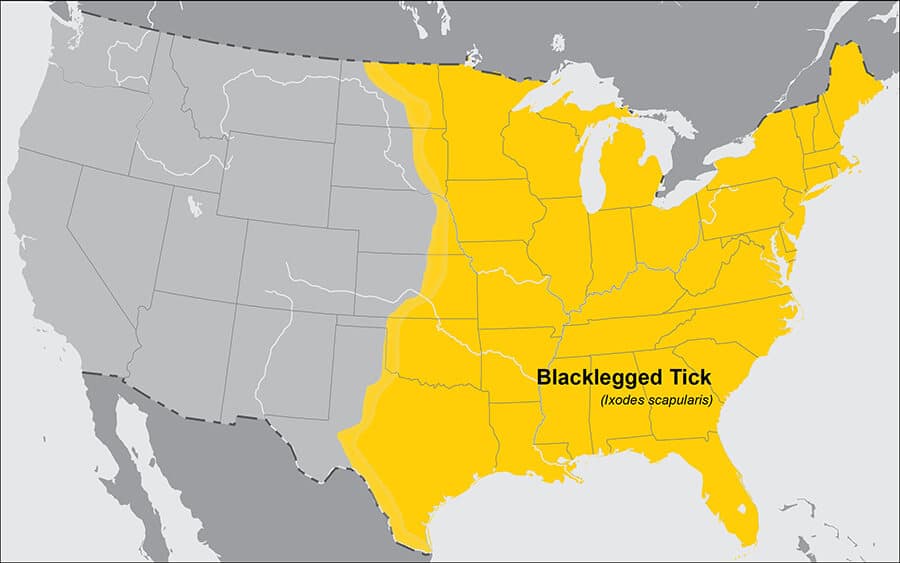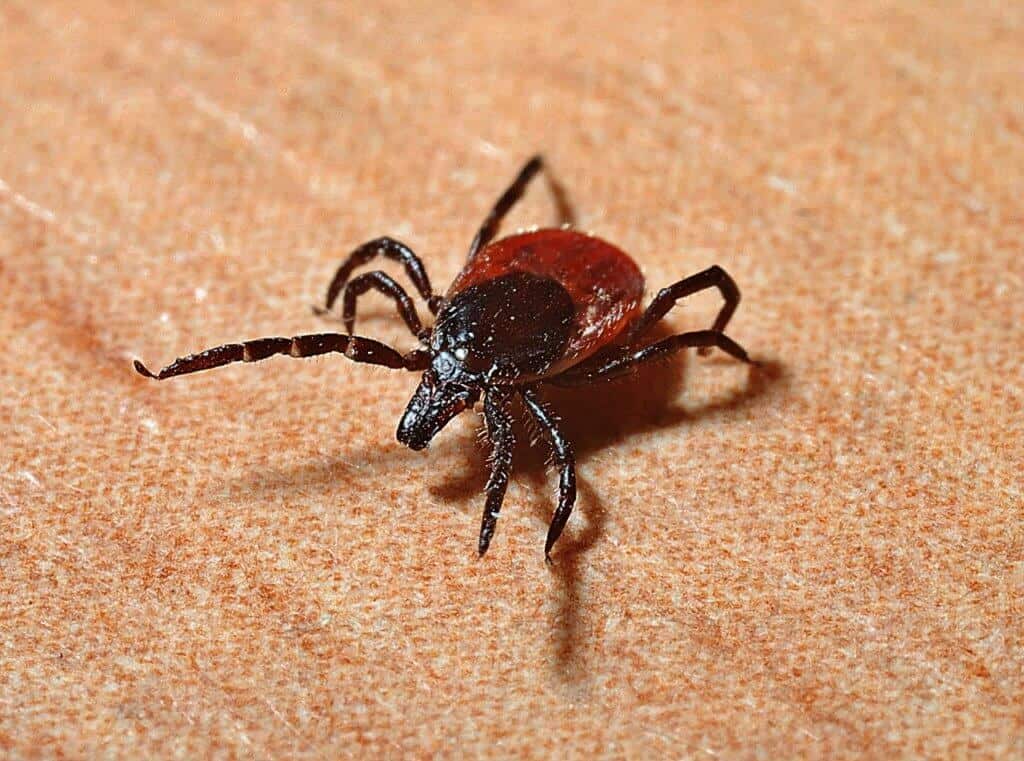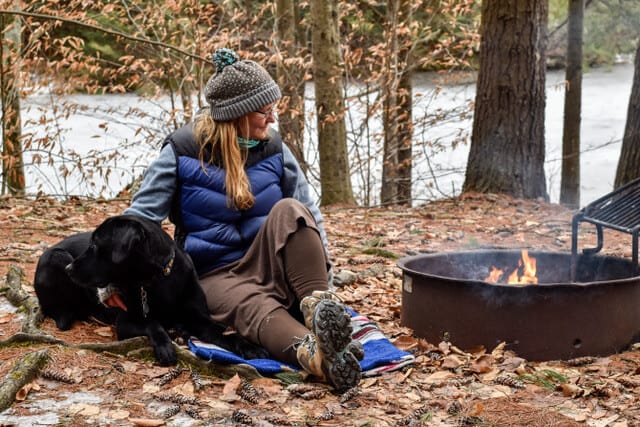8 Genius Ways to Avoid Ticks While Hiking and Camping
Note: Advertising is how we keep this site free for you to enjoy, and we earn a commission from affiliate links that may be included in this post. Thank you for supporting Back Road Ramblers!
If you spend time hiking or camping in the eastern half of the United States, chances are you’ve had encounters with ticks, and perhaps even Lyme disease, which is a serious tick-borne illness that affects humans and dogs who enjoy the outdoors.

Growing up, I was blissfully unaware of ticks and all the troubles that they can cause, and decades later, I think we are still in the dark about many tick-borne diseases.
As a young adult, both my husband and I were diagnosed with Lyme disease, and while our symptoms were relatively mild and our treatment swift, we later lost a dog to Lyme disease, which was thoroughly heartbreaking.
Fast forward a few decades, and we now know many people who no longer enjoy hiking or camping due to the threat of ticks and tick-borne diseases. As a result, we have definitely changed the way we explore the outdoors to minimize the risk.
While ticks and tick-borne diseases pose a serious threat, so does staying inside!
With hiking season in full swing and camping season right over the horizon, I’d like to share some of our essential tips for how to avoid ticks while hiking and camping.
Once you get used to taking precautions, you’ll find that ticks are just another nuisance instead of a deal-breaker.
Where are Ticks Found in the United States?

Ticks that bite humans and transmit disease can be found in every single state in the contiguous USA.
The deer tick or blacklegged tick (Ixodes scapularis) is the one that transmits Lyme disease as well as other nasty illnesses such as anaplasmosis, babesiosis, ehrlichiosis, and Powassan virus disease.
While the abundance of the black-legged tick varies locally, it is widespread across the eastern United States.
The deer tick thrives in fields and woodlands where there is an abundance of deer and mice, which are their favorite hosts.
Ticks are most active in spring and fall, but we have seen them in winter when temperatures rise above freezing. We rarely see ticks above 2,000 feet here in Vermont, but have seen them at higher elevations further south.
Tick-Borne Diseases are Becoming More Common

Lyme disease is a bacterial infection caused by two types of bacteria — Borrelia burgdorferi and Borrelia mayonii, which are transmitted by deer ticks.
In the US, bacteria are transmitted to humans and dogs through the saliva of a tick during a bite.
When a tick bites a human or animal, it firmly latches onto the skin to feed and will gorge itself on human or animal blood for days if it isn’t interrupted. The longer a tick is attached to your skin, the greater the risk of disease transmission.
More than 400,000 people are diagnosed with Lyme disease in the United States each year. While most cases can be successfully treated with antibiotics, preventing tick bites and avoiding ticks while hiking remains the best approach.
Lyme Disease Symptoms in Humans

The tell-tale sign of Lyme disease is a bull’s-eye rash, but in reality, only 9% of Lyme disease patients report having this rash.
Other rashes are more common, and about 50% of infected patients report some type of rash. In our family, my husband had the classic bull’s eye, so it was a very easy diagnosis. I had a rash that looked nothing like a bull’s eye, so my diagnosis required a blood test.
Other symptoms of Lyme disease are easy to miss because they are very similar to other illnesses like the flu or the common cold. Symptoms include:
- Flu-like illness with a fever
- History of a tick bite – in our case, neither my husband nor I remembered having a tick bite before developing symptoms.
- Headache
- Extreme fatigue
- Other rashes (Only found in 50% of patients)
- Red cheeks or ear lobes
- Jaw Pain
- Neck & Back Pain
- Joint pain and swelling
- Bone pain
As a hiker, it isn’t uncommon to experience sore muscles and joint pain, which were my primary symptoms. It was only when the pain didn’t go away after several days of rest that I sought medical attention.
Lyme Disease Symptoms in Dogs

Lyme disease symptoms in dogs are very similar to those in humans, the main difference, of course, is that your dog can’t tell you how he’s feeling. Symptoms of Lyme disease in dogs include:
- Fever
- Loss of appetite
- Reduced energy
- Lameness (can be shifting, intermittent, and recurring)
- Generalized stiffness, discomfort, or pain
- Swelling of joints
We’ve had two dogs with Lyme disease.
Our first dog, Amos, went to bed one night without any symptoms at all, and by morning, he couldn’t walk and could barely stand. We took him to our vet, who said this was a classic case. We treated him with antibiotics, and he was as good as new within a few days.
Our second dog, Kaleb, had very mild symptoms, which we thought were simple signs of aging.
He started slowing down on walks and taking more naps, but otherwise, he was pretty happy. We took him to the vet for frequent urination, thinking he had a UTI. It turned out that his kidneys were failing due to untreated Lyme disease.
We lost him within a week of his diagnosis.
Is there a Vaccine for Lyme Disease?
There is no human vaccine for Lyme disease, and the only way to avoid getting it is to be vigilant about preventing tick bites. As for dogs, a Lyme vaccine exists, but it does not provide complete protection, and there are side effects in some dogs. The Lyme vaccine must also be administered annually to be effective.
We live in an area that is VERY prone to ticks that carry Lyme disease, and the dog we lost is always in the back of our minds when we make our decision. For now, we are choosing to vaccinate, as we trust our team of veterinarians and they recommend it.
If you are interested in learning more about the Lyme vaccine for dogs, Whole Dog Journal has some good information.
If you live in an area where Lyme disease is an issue, the best course of action is to talk to your veterinarian about your choices.
While Lyme disease remains the most common tick-borne disease transmitted to humans, others are emerging more frequently.
Anaplasmosis & Ehrlichiosis
Think of them as tick tag-teams.
Both are bacterial infections spread by blacklegged or lone star ticks. Symptoms can sneak up on you with fever, headache, body aches, and sometimes a rash. They’re the second most common tick-borne disease in the U.S., so they’re not rare, but they are treatable if caught early.
Rocky Mountain Spotted Fever (RMSF)
Despite the name, it’s not just in the Rockies.
This one hits hard and fast. It starts with flu-like symptoms, followed by a rash that can vary in appearance. RMSF can be life-threatening if untreated, so if you feel off after a tick bite, don’t wait — get checked out.
Babesiosis
A tick-borne parasite party (that you didn’t RSVP to).
Caused by tiny parasites invading your red blood cells, babesiosis may feel like the flu, or nothing at all. It can be dangerous for folks with weak immune systems, so don’t ignore symptoms like chills, fatigue, or anemia.
Tularemia
AKA “rabbit fever,” but ticks carry it too.
Dog ticks, wood ticks, and lone star ticks can pass this along. Watch for skin ulcers, swollen glands, and high fever. While it’s rare, tularemia is potent and rising in the central U.S.
Powassan Virus
The stealthiest one of the bunch.
Powassan (or POW) is rare but serious. It can infect the brain or spinal cord, causing symptoms like confusion, speech trouble, and seizures. There’s no specific treatment, so prevention is key — stay tick-aware in the Northeast and Great Lakes regions.
Heartland Virus
Not romantic. Not fun.
First identified in Missouri, this viral illness is spread by lone star ticks and brings on fever, fatigue, and joint pain. It’s rare — just 40 confirmed cases — but nearly everyone infected needed hospitalization.
Tick-Borne Relapsing Fever (TBRF)
It’s like a fever rollercoaster.
Transmitted by soft ticks (usually found in rodent-y cabins, not the woods), TBRF causes high fevers that come and go every few days. It’s more common out west, so maybe pass on that sketchy mountain shack?
Alpha-Gal Allergy (Red Meat Allergy)
Yes, a tick can make you allergic to burgers.
Thanks to a sugar molecule called alpha-gal, some people develop a red meat allergy after a Lone Star tick bite. Symptoms include rash, nausea, and even anaphylaxis, and reactions are delayed, sometimes hitting hours after you eat that steak.
Read Next: Make Your Own Road Trip First Aid Kit
How to Avoid Ticks While Hiking and Camping

You’ve got to be vigilant without being afraid.
Take the necessary precautions and get out there. The health benefits of hiking, camping, paddling, and climbing are worth the extra effort required to stay safe and tick-free.
Here are our best tips for preventing tick bites when camping and hiking.
Before You Head Out on Your Hike
Lightweight long pants or leggings are best for hiking during the tick season.
Choose a light color so that ticks are easier to spot, and tuck your pants into your socks. Your bottom half is the most vulnerable, as ticks will often wait in the tall grass, waiting to hitchhike on your clothing before looking for a meal. Tuck your shirt into your pants to make it harder for ticks to find a way in.
Sawyer makes a Permethrin spray that you can use on your clothing and gear (not on your skin), which will last for six washes or six weeks.
Spray your clothing outside when there is little to no wind and leave it to dry for several hours before wearing. We use Permethrin spray on our hats, boots, backpacks, tents, and clothes, as well as our dog’s bandanas, collars, and backpacks.
Best Tick Repellent for Hiking and Camping
As for tick repellent, we have tried everything, from all-natural essential oils to the most potent DEET-based chemicals. What we use depends on many factors — where we are hiking, how long we’ll go without washing, and what we’re wearing.
Here are the tick-repellent products we love and what we use them for:
Murphy’s Naturals – Not only has Murphy’s Naturals created an effective all-natural mosquito and tick repellent, but they are B-Corp certified and members of 1% for the Planet. We have found the insect repellent to be extremely effective against ticks. It’s made from 30% lemon eucalyptus oil—the only plant-based mosquito repellent recommended by the CDC. Our only complaint is that the spray must be reapplied frequently to remain effective.
Sawyer 12-hour Picaridin Spray – Picaridin is a spray made from synthesized ingredients from the pepper plant. It is comparable to DEET in its effectiveness, has very little odor, and can be safely used on the skin. This spray contains 20% Picaridin, and we use it for long hikes and camping trips. Note that this product comes in a lotion or spray, but we have not found the lotion to work as well as the spray.
Bonus: Picaridin has proven to be awesome at preventing bites from flies and mosquitoes.
DEET products – DEET has been used and studied more than any other product on the market and is definitely proven to be effective against ticks. We use DEET for day hikes and evenings around the campfire, but only if we know we can wash within a reasonable amount of time. I will often give my pants and shoes a spray with DEET before heading out the door, but we rarely use DEET products on our bare skin, as we don’t like the way it feels or smells, and it can damage plastics and synthetic clothing.
Read Next: The Complete Guide to Hiking with Kids
More Ways to Avoid Ticks While Hiking
You’ve pretreated your clothes, smothered yourself in repellent, and are ready to hit the trail. Is there anything else you can do to avoid ticks while hiking?
Yes! If you’re hiking in the woods, you are hiking in the deer tick’s home territory, but you can still take steps to avoid them.
Stay on the trail. A well-trodden trail will have fewer ticks than tall grass and underbrush, so keep bushwacking to a minimum when hiking in areas where ticks may be present. If you do have to hike off-trail, stop every so often and check your pants and your dogs for ticks.
Watch where you sit. Ready for a snack break? Don’t just park it any old place. Instead, look for open areas like large rocks, logs, or other spots without a lot of vegetation. Don’t lean against trees if you can help it, and check your clothing for ticks before getting back on the trail.
See the kid below? Don’t do what he’s doing, and if you do, give yourself a thorough tick check afterward.

Hike in higher elevations. The higher you go, the fewer ticks you’ll find.
Check yourself for ticks often. I make a habit of looking down at my socks and pant legs every five to ten minutes while hiking. Ticks usually start off low and climb until they find bare skin. If you can catch them early, you can simply pick them off your clothes instead of pulling them out of your skin. Wearing light clothing makes them very easy to spot.
How to Keep Your Dog Safe from Tick Bites
We’ve talked a bit about the Lyme vaccine, but that won’t prevent your dog from getting tick bites. It will simply lower the risk of your dog contracting Lyme disease, and other tick-borne diseases are equally nasty, for which vaccines won’t provide protection (anaplasmosis and babesiosis are becoming endemic in our area).
There are numerous products available, ranging from sprays and collars to oral and topical medications.
What you use depends largely on where you live and how often you hike, but I strongly suggest consulting with your veterinarian before deciding how to proceed.
When ticks are most active, during the spring and fall, we use Vectra on both our dogs, as well as bandanas treated with Permethrin. When tick activity slows down in the winter, we stop applying Vectra.
We check our dogs for ticks during our hike and give them a more thorough check when we get home.
We call it a doggy massage and do it by feel. Our dogs love that! Because ticks are such a huge part of living in the Northeast, it’s just second nature to check for ticks on ourselves and our dogs several times a day.
Read Next: Summer Adventures are Better with Dogs
How to Remove a Tick
I have honestly removed hundreds of ticks from myself, my dogs, and the people I love. It’s not much fun, but it’s become a habit.
We have been advised to use rubbing alcohol and tweezers or a special “tick key” to do the job, but I rarely have tweezers on me when I spot a tick, and I never have rubbing alcohol. However, I sometimes have hand sanitizer with me, which works just as well.
I use my fingernails to grab the tick as close to the skin as possible, and I pull it out slowly and gently so as not to leave any yucky tick parts in the skin.
I try to wash up as soon as possible after removing the tick, both at the site of the wound and on my hands, which have been handling the tick.
Further Reading about Ticks and Lyme Disease
Lyme disease is no joke, and you are no doubt fascinated by this whole subject and just itching to learn more about ticks, Lyme disease, and insect repellents.
You’re in luck because there is a wealth of information available, and this blog has barely scratched the surface of all the disturbing details.
If you live in an area where ticks are present, like to spend time outdoors, or just think creepy crawlies are cool, you need to check out these sites.
Centers for Disease Control and Prevention Lyme Disease Page – Just about everything you could want to know about Lyme disease, including diagnosis, statistics, and up-to-date research.
American Veterinary Medical Association Lyme Disease Page – Information on Lyme disease in dogs, including vaccine info, diagnosis, and symptoms.
Here’s What Happens When a Tick Bites You – Watch this National Geographic video and you may never go in the woods again, and if you do, you’ll definitely wear insect repellent.
Insect Repellent Guide: DEET vs. Picaridin vs. all-natural – If you just can’t figure out which insect repellent to use while hiking, check out this article from REI. It covers all the basics and was instrumental in helping us navigate the different sprays and repellents available.
Follow us on social media and never miss a post!






